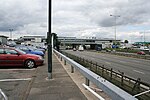Leicestershire ( LEST-ər-sheer, -shər) is a ceremonial county in the East Midlands of England. It is bordered by Derbyshire, Nottinghamshire, and Lincolnshire to the north, Rutland to the east, Northamptonshire to the south-east, Warwickshire to the south-west, and Staffordshire to the west. The city of Leicester is the largest settlement and the county town.
The county has an area of 2,156 km2 (832 sq mi) and a population of 712,300. Leicester occupies the centre of the county and is by far the largest settlement, with a built-up area population of 357,000. The remainder of the county is largely rural, and the next-largest settlements are Loughborough (65,000), Hinckley (50,000), and Coalville (22,000). For local government purposes Leicestershire comprises a non-metropolitan county with seven districts, and the unitary authority area of Leicester.
Leicestershire is generally a lowland county, characterised by small, rolling hills. It is bisected by the River Soar, which rises near the Warwickshire border south of Hinckley and flows north through Leicester and Loughborough before reaching the Trent at the county boundary. To the west of the river is Charnwood Forest, an upland area which contains Bardon Hill, which at 278 m (912 ft) is the county's highest point.
There are Prehistoric earthworks in the county, and Leicester was a Roman settlement. The region was settled by the Angles in the sixth century and became part of the Kingdom of Mercia, and the county existed at the time of the Domesday Survey in the 1080s. The county has had a relatively settled existence, however it was the site of the Battle of Bosworth Field in 1485, in which established the Tudor dynasty's position as monarchs of England. During the Industrial Revolution the Leicestershire coalfield in the north and west of the county was exploited. Leicester became known for shoemaking, and with Loughborough continues to be a manufacturing centre. In agriculture the county is known for Stilton cheese and Melton Mowbray pork pies.







